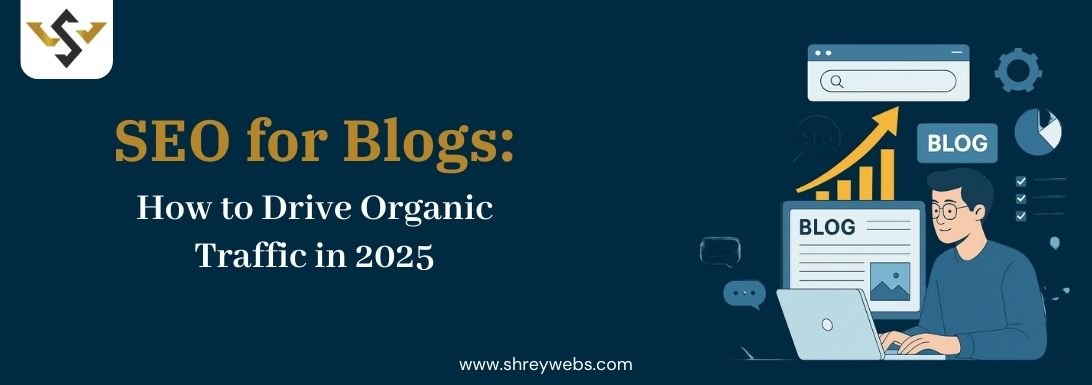Introduction- Why SEO Still Matters for Blogs in 2025
Even in 2025, blogging remains one of the best ways to build a direct connection with readers, showcase knowledge, and grow organic search traffic. Yet posting a new article is no longer enough. The competition is fiercer, and search algorithms keep getting tougher. Solid SEO for blogs solves this problem. Carefully optimizing each post helps it get noticed, brings in a wider audience, and cements your authority in the topic for years to come.
Exploring the Basics of SEO for Blogs
seo for blog posts boils down to two main tasks: help search engines find your content and make it rewarding for actual readers. Unlike static site pages, blog entries thrive on regular updates, keyword-rich focus, and a tidy format. Today, Google prioritizes experience, which means relevance, search intent, and quality are far more important than cramming in keywords.
When implemented correctly, SEO tips for blogs help you:
- Compete on both popular and niche search queries.
- Earn trust from visitors and search engines.
- Drive steady traffic that builds over time.
Core SEO Tips for Blogs in 2025
Keyword Research for Blog Posts.
Keyword research remains the backbone of search-friendly blogs. Instead of chasing the broadest-sounding terms, pay attention to user intent and longer, more specific phrases. Take “how to optimize a blog post for SEO”- it often attracts fewer clicks than “SEO for blogs,” yet the searchers know exactly what they want. Not all phrases need to be super high volume; the right intention is what drives engaged readers. Run your lists with Google Keyword Planner, Ahrefs, or Semrush to make sure you consistently aim for terms that boost steady blog visits.
Crafting SEO friendly blogs
Making a seo friendly blogs is about more than pasting a few keywords. Title tags, meta descriptions, and headers need to mirror what users are actually looking for. Internal links should guide readers to related articles and pages that support your main subject. For example, a full on-page SEO audit checklist not only serves anyone reading it, but it also guides search engines in piecing the larger story together. Use clear subheadings and well-placed links to give a tight, clear path.
Technical SEO for Blog Posts
Strong technical SEO forms the hidden backbone of every successful post. Start with a clean, responsive design, so your articles reformat smoothly on smartphones and tablets. Please enhance the loading time, utilize a straightforward heading structure, and maintain short, descriptive URLs. When each detail is in place, search engines have the clearest signal to give your post a favorable ranking. Want to tidy up your links? Check out the article on What Is URL for seo.
How to Optimize a Blog Post for SEO Step by Step

On-Page Optimization
To boost the SEO for a new blog post, start with the on-page details. Use the main keyword in the title tag, the first 100 words, and at least two subheadings. Sprinkle related keywords inside the content where it feels smooth, never forced. The goal is to guide the search engine while keeping the reader engaged.
Enhancing Readability & Engagement
A perfectly keyworded post falls flat if it’s difficult to read. Keep the paragraphs to 2–4 sentences. Use numbered lists, bullet points, and images to break up text. This layout isn’t just for the audience; search engines reward posts that readers linger.
Team Up with AI Content Tools
AI has become an integral part of content strategy. From generating topic ideas to enhancing readability, these tools can streamline the process. A deeper dive into content creation with AI shows how modern bloggers can combine creativity with technology.
Key Steps to Improve Your Blog Post
1. Choose & Strategize Around a Target Keyword
Every successful post begins with a carefully selected target keyword. Pick one that aligns with your audience’s search intent and has a realistic chance of ranking. Build your outline and supporting terms around it instead of forcing keywords in after writing.
Optimization Hack: Use long-tail variations and questions to capture extra search queries.
2. Write for Humans First, Search Engines Second
Google rewards content that satisfies readers. Focus on clarity, value, and solutions before worrying about optimization. An engaging post will naturally earn longer dwell time and shares, which improve SEO signals.
Optimization Hack: If a human wouldn’t enjoy reading it, don’t expect Google to rank it.
3. Use SEO Reports to Guide Writing & Editing
SEO tools provide insights into keyword difficulty, readability, and performance gaps. Use these reports to refine headlines, strengthen sections, and fill missing keyword opportunities.
Optimization Hack: Regularly audit older blogs to spot posts that can climb higher with minor updates.
4. Strategically Place Internal & External Links
Linking is a ranking booster when done right. Internal links guide readers to other valuable content on your site, keeping them engaged. External links to reputable sources build trust and credibility.
Optimization Hack: Add links naturally within the flow—never force them.
5. Add Visuals & Optimize Alt-Text
Images, infographics, and charts break up text and improve comprehension. But don’t stop at visuals—alt-text helps search engines understand them and boosts accessibility.
Optimization Hack: Use descriptive alt-text like “SEO tips for blogs infographic” instead of “image1.”
6. Improve Readability & Scannability
Readers skim. Use headings, subheadings, bullet points, and short paragraphs to make your content easy to digest. Well-structured posts lower bounce rates and signal quality to search engines.
Optimization Hack: Run your draft through a readability tool to ensure it’s accessible to a wide audience.
7. Include Strong CTAs to Drive Action
A blog should guide readers to the next step—whether it’s subscribing, downloading, or contacting you. Strong CTAs not only build conversions but also show Google your page delivers value.
Optimization Hack: Place CTAs contextually inside posts, not just at the bottom.
8. Craft Click-Worthy SEO Titles & Meta Descriptions
Titles and meta descriptions determine whether users click your link in search results. Make them descriptive, keyword-rich, and enticing without being clickbait.
Optimization Hack: Keep titles under 60 characters and meta descriptions under 160.
Strategies to Increase Blog Traffic in 2025

Growing a blog in 2025 requires more than publishing new content—it’s about working smarter, staying consistent, and adapting to how users consume information. Here are powerful strategies to help you increase blog traffic this year and beyond:
1. Focus on Evergreen Content
Evergreen blog topics that remain relevant for years continue to drive steady organic traffic. Posts like “Beginner’s Guide to SEO for Blogs” or “How to Optimize a Blog Post for SEO” provide long-term value, attracting new readers every month. Make sure to refresh them annually with updated stats, links, or examples.
2. Update and Repurpose Existing Blogs
Older blogs often lose rankings if they’re outdated. Instead of creating new posts from scratch, update existing ones with:
- Fresh statistics and trends.
- Improved internal linking to related posts.
- New keywords to align with current search intent.
You can also repurpose content into infographics, short videos, or social media threads to capture different audience segments.
3. Leverage Search Intent & Long-Tail Keywords
Search intent has become central to rankings. Instead of just targeting broad terms, use long-tail queries that answer specific questions. For example:
- Broad: “SEO for blogs”
- Long-tail: “best SEO tips for blogs in 2025”
Long-tail keywords help you rank faster and attract readers who are closer to taking action.
4. Build a Strong Internal Linking Structure
Strategic internal links guide readers through your blog and distribute ranking power across posts. Linking to resources like an on-page SEO audit checklist or related guides not only improves SEO but also keeps visitors engaged longer.
5. Promote Across Multiple Channels
Don’t rely solely on search engines. Share your posts on:
- Social media platforms: LinkedIn, Twitter/X, and Instagram for reach.
- Email newsletters: Regular updates build loyal readership.
- Communities & forums: Platforms like Reddit, Quora, and niche groups drive targeted traffic.
6. Optimize for Featured Snippets & Voice Search
With the rise of AI search assistants and voice queries, blogs that directly answer questions (in a clear, concise way) have higher chances of being picked as featured snippets. Use FAQ sections, bullet points, and structured answers to increase visibility.
7. Collaborate & Guest Post
Partnering with other bloggers, businesses, or influencers in your niche expands your reach. Guest posts on authority sites can send referral traffic while boosting your blog’s credibility.
8. Use Analytics to Refine Strategy
Consistently track what works. Tools like Google Analytics and Search Console reveal:
- Which keywords bring the most traffic.
- Which blogs generate leads or conversions.
- Where users drop off.
This data helps you refine and scale your content plan effectively.
Common SEO Mistakes to Avoid
Even seasoned creators slip up. Here are the blunders that still cause pain:
- Keyword stuffing: Shoving in the same keyword over and over makes sentences awkward and readers leave.
- Ignoring technical SEO: A site that loads slowly or doesn’t work well on phones gets pushed down faster than you can notice.
- Ignoring voice search and rich results: In a few years, voiced queries and excerpts will dominate search.
Skip these pitfalls and watch your traffic boom while rivals struggle to catch up.
The Future of SEO for Blog Posts
Looking ahead, blog SEO will shift to hyper-personalization and a flawless reader experience. AI will whisper personalized suggestions, voice and image searches will broaden, and rich media- videos, animated graphics, and things readers can click on- will partner with blog text to hold readers’ eyes longer.
Instead of just targeting keywords, smart bloggers will analyze intent: why the user searched, what they need, and how best to answer it.
In summary, using SEO to propel long-term blog success
Mastering SEO for blogs in 2025 is about balance—optimizing for search engines while delivering real value to readers. By applying these strategies, you can create SEO friendly blogs that attract audiences, generate leads, and build authority. Whether you’re learning how to optimize a blog post for SEO or seeking ways to increase blog traffic, consistency and adaptability are the keys.
Try small changes, review your results, fine-tune again. Keep this cycle going, and your blog will keep humming along as a reliable source of organic traffic for years to come.

